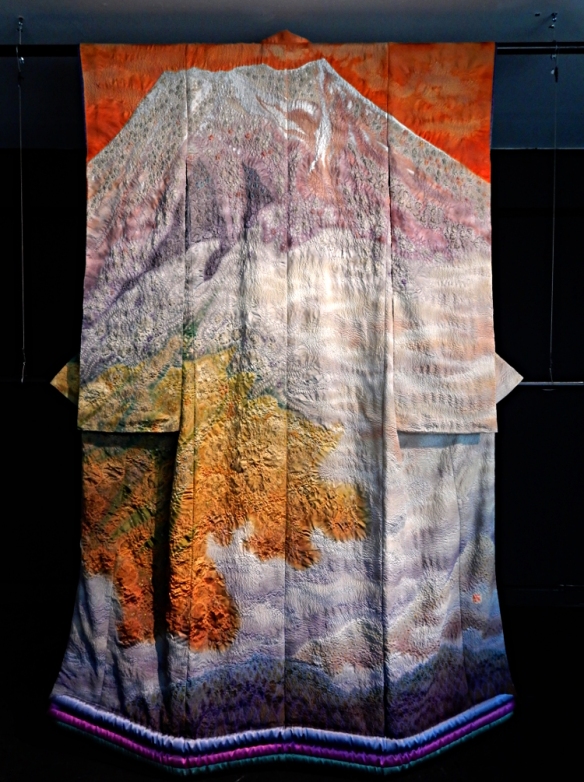Yuzen Dyeing is a traditional process for decorating silk which uses a paste resist made from glutinous rice to contain dyes within desired boundaries. It can be thought of as a sophisticated production version of the western “Serti” technique for silk painting. While Yuzen dyeing is carried out in many parts of Japan the most famous traditional area of production was the “Kaga” region, an old province, now part of Ishikawa Prefecture on the North coast of Honshu.

Restrained, traditional Kaga Yuzen Kimono at the Kanazawa Museum for Traditional Products and Crafts
Kaga Yuzen production was centred in Kanazawa and the decorated Kimono silk from this area became famous from the eighteenth century onwards. The distinguishing features were highly naturalistic designs based on plants and animals and a colourful but strictly limited palette.
During our visit to Japan this year, Alex and I travelled to Kanazawa to see what we could learn about Kaga Yuzen dyeing as practised today. Our first port of call was the city’s Museum for Traditional Products and Crafts. This was a very interesting place to visit with some great exhibits by young craftspeople but it only had a few Kimono and very little information.

Kaga Yuzen features fine white lines between the blocks of colour and often has fine shading within the colour areas (Click to enlarge)
Our next port of call was Kaga Yuzen Traditional Industry Centre, a sort of co-operative education and marketing effort for all the local producers. Sadly this featured the same disappointments we encountered at a few other venues in Japan: no photography permitted and a distinct feeling that they only really cared about you spending time in the gift shop buying the quite pricey and often slightly tacky souvenirs. Still, the displays did feature many Kimono including some with very dramatic and unusual compositions. We were also able to sit and watch a lengthy TV documentary on Kaga Yuzen dyeing. One thing the displays at this Centre made clear was that today’s Kaga Yuzen dyers have now largely abandoned the traditional restricted and restrained colour schemes in favour of much more exuberant, sweet and perhaps even syrupy hues.

The Kaga Yuzen Traditional Industry Centre had lots of Kimono on show but was disappointing
The next day we went to a privately run Kaga Yuzen studio, the Nagamachi Yuzen Kan. Here we were made very much more welcome with photography positively encouraged and a helpful guide who tried hard to be informative, despite speaking little English. I suspect that this studio makes most of its income through teaching but it had a large gallery full of Kimono on display. The sweet, bright pastel colours were again in evidence but the technique shown was superb.

The Nagamachi Yuzen Kan had a large gallery space and a welcoming atmosphere

A design drawing.
The Kaga Yuzen process can be summarised as:-
1. The design drawing is transferred to the silk over a lightbox using fugitive ink that will wash out.
2. The design is outlined in very fine lines using a bag of rice paste and a fine nozzle similar to that used in cake decoration

An artist’s work table. Note the heater set into the surface to dry the dyes
3. The individual areas of colour are painted in. Artists use an electric heater to quickly dry the dyes so that they do not run and work on the different sections of Kimono fabric simultaneously.

Artists work on several pieces at once. Bent bamboo strips with pins in each end are used to stretch the silk
4. The fabric is given a short steaming to fix the painting before all the design areas are coated with rice paste resist.
5. The fabric is stretched and the background is rapidly coloured in using a large brush.

The black background was painted after the design was fixed and covered with resist
6. The fabric is given a final steaming to fix all the colours
7. The silk is washed to remove all the rice paste and excess dye. Formerly this was done in the local rivers but now this only happens during festivals and special events to entertain tourists.
8. After drying and ironing the finished fabric is made up into a Kimono.

A finished Kimono

Wai-Yuk Kennedy – Kaga Yuzen artist!

































































































